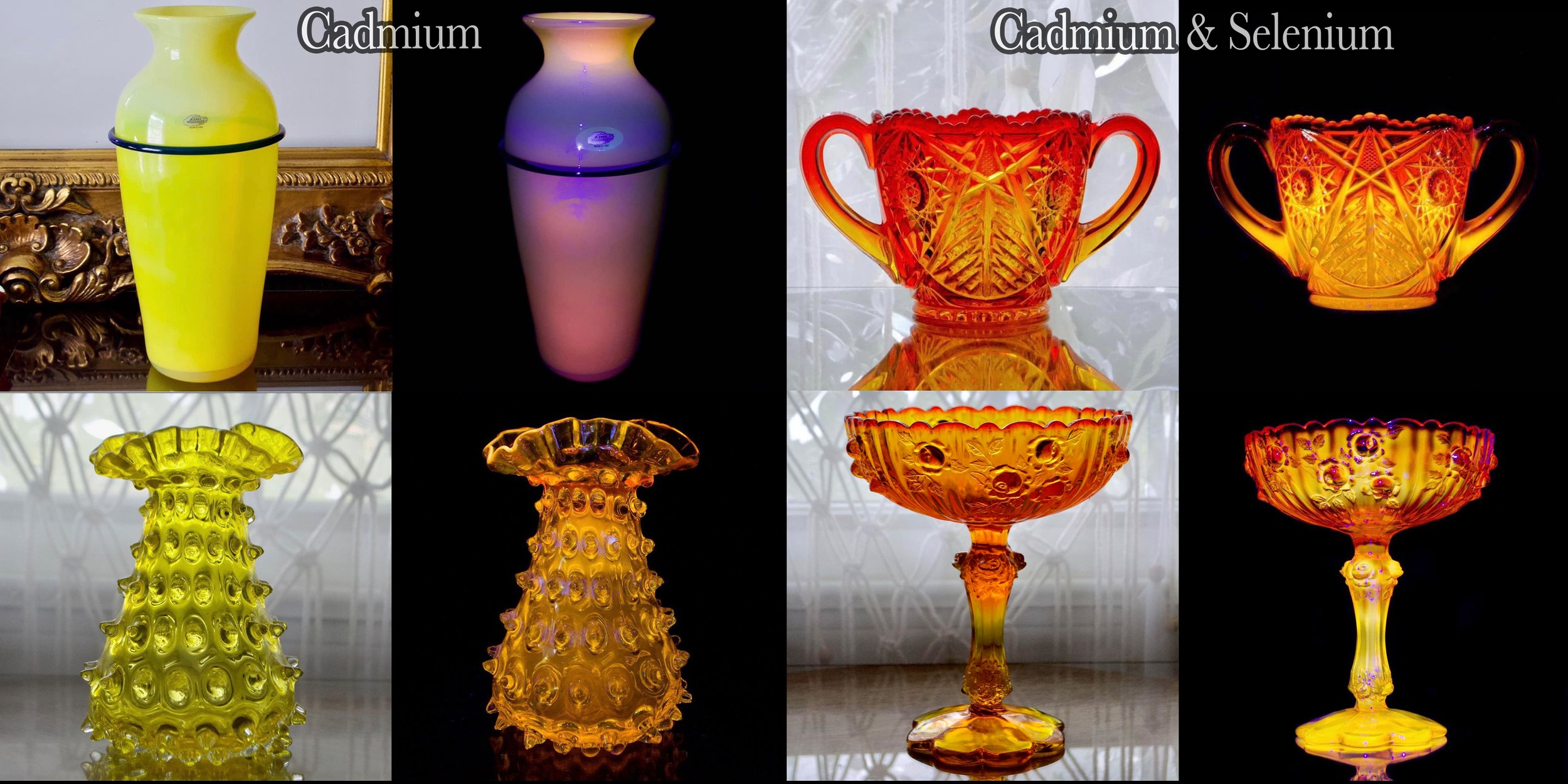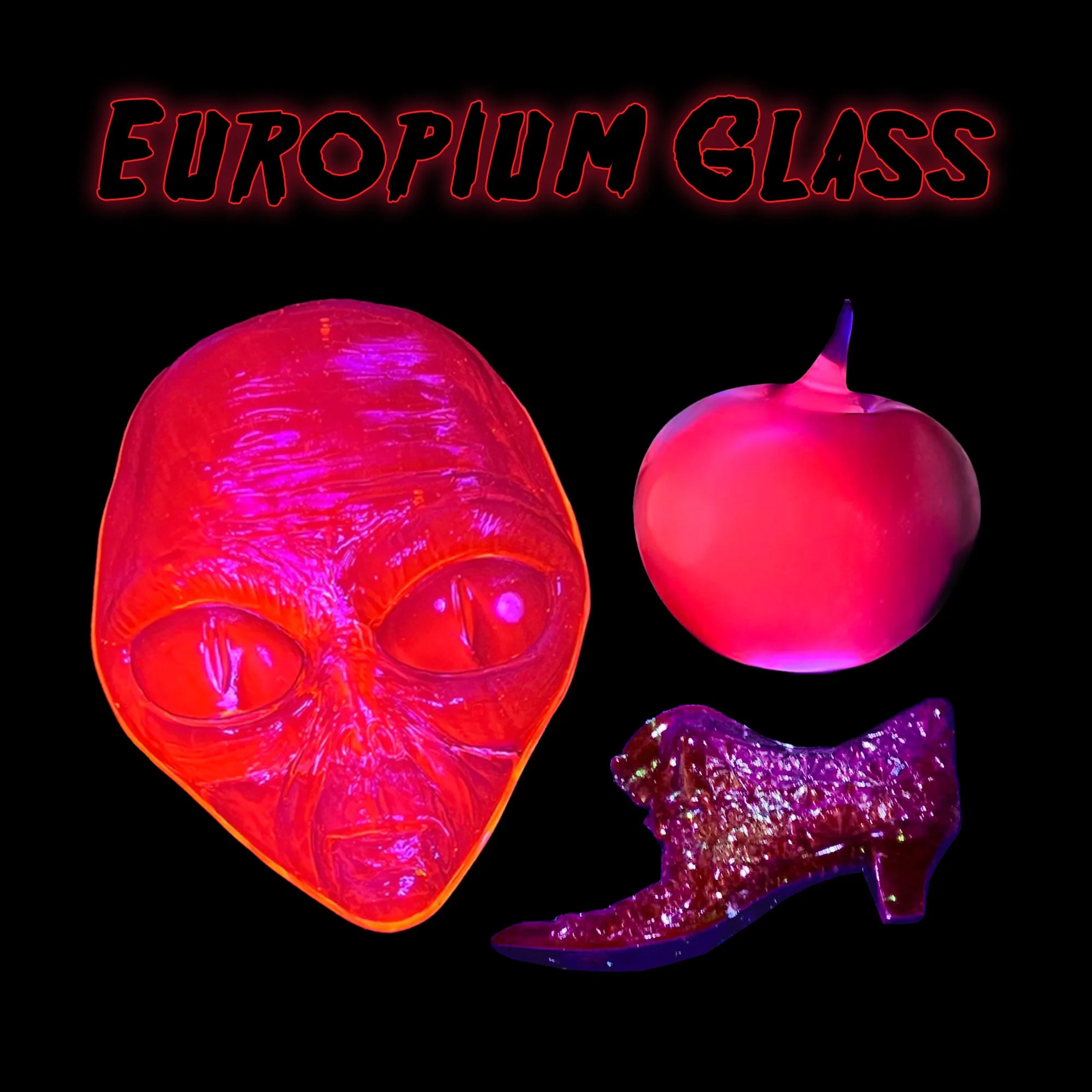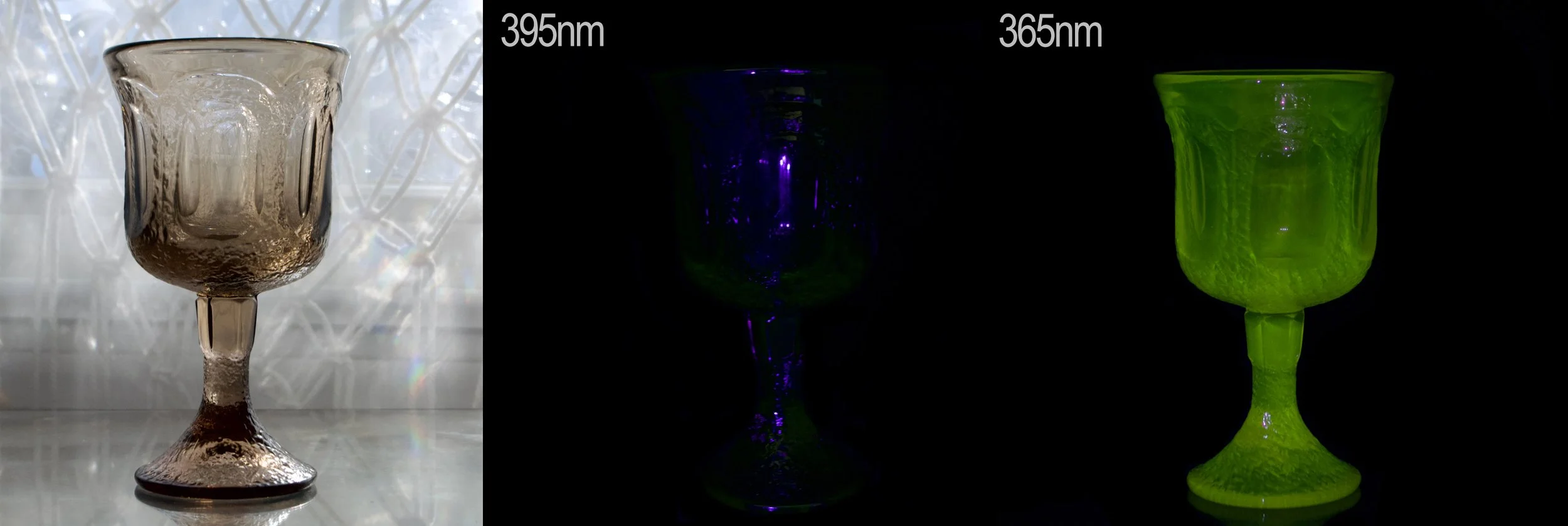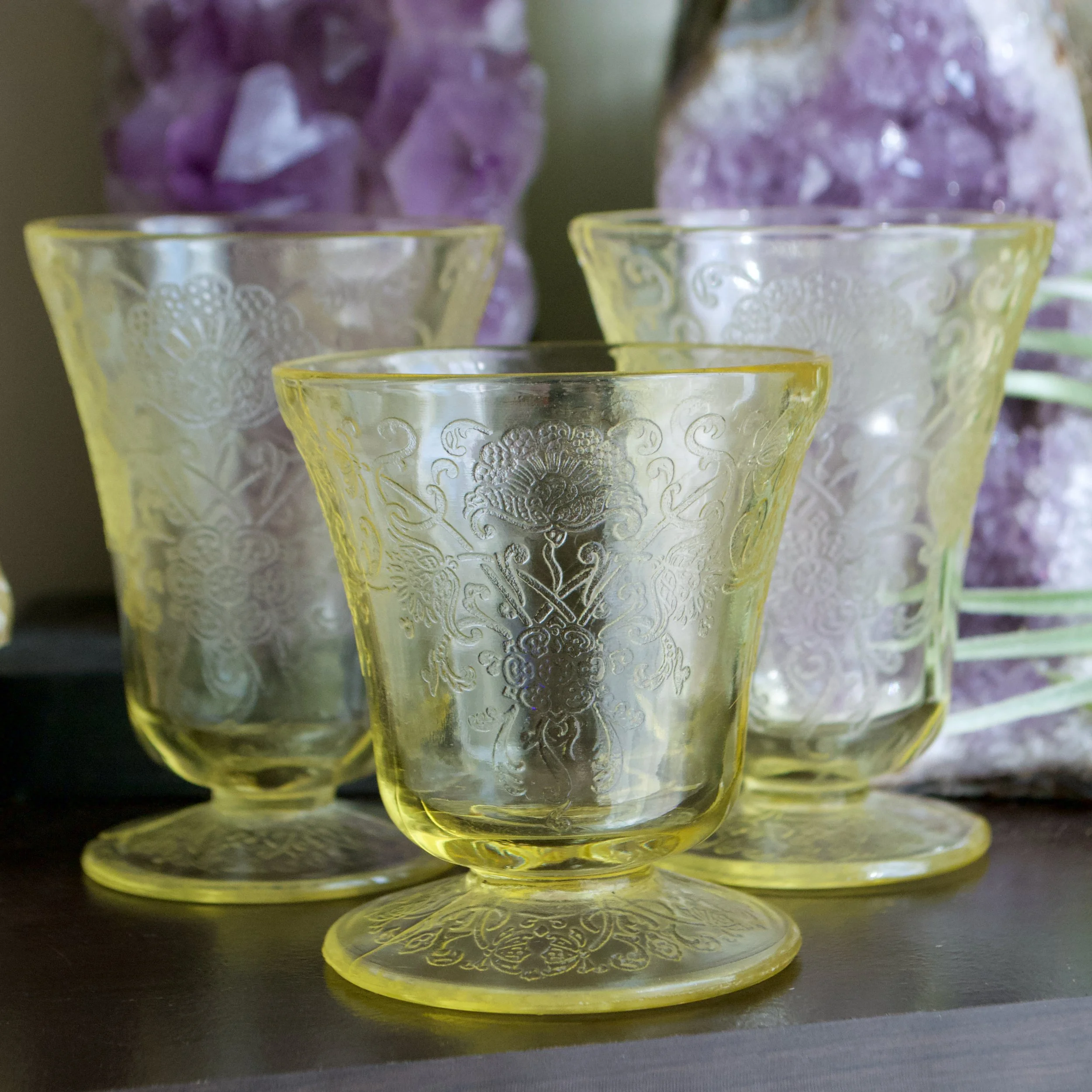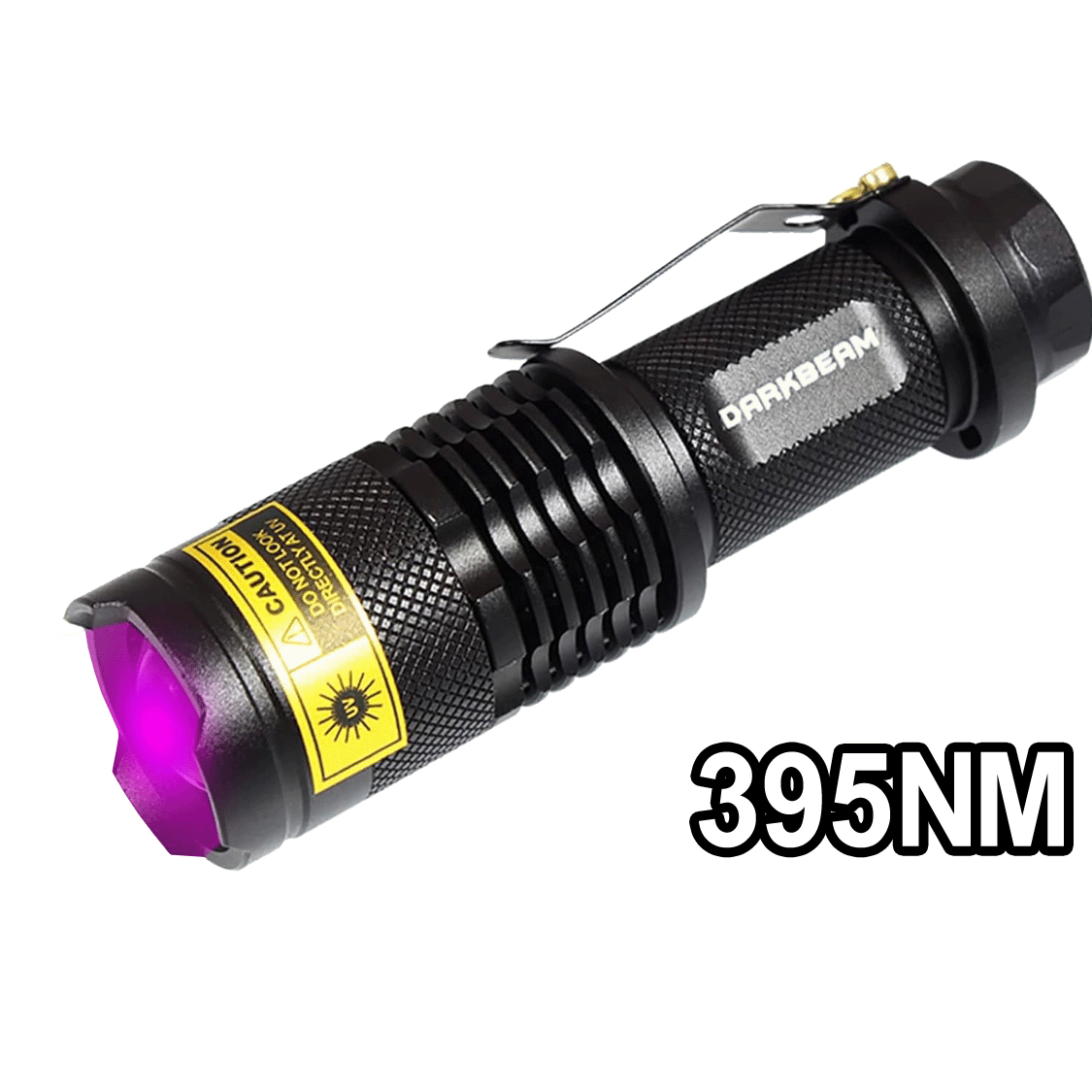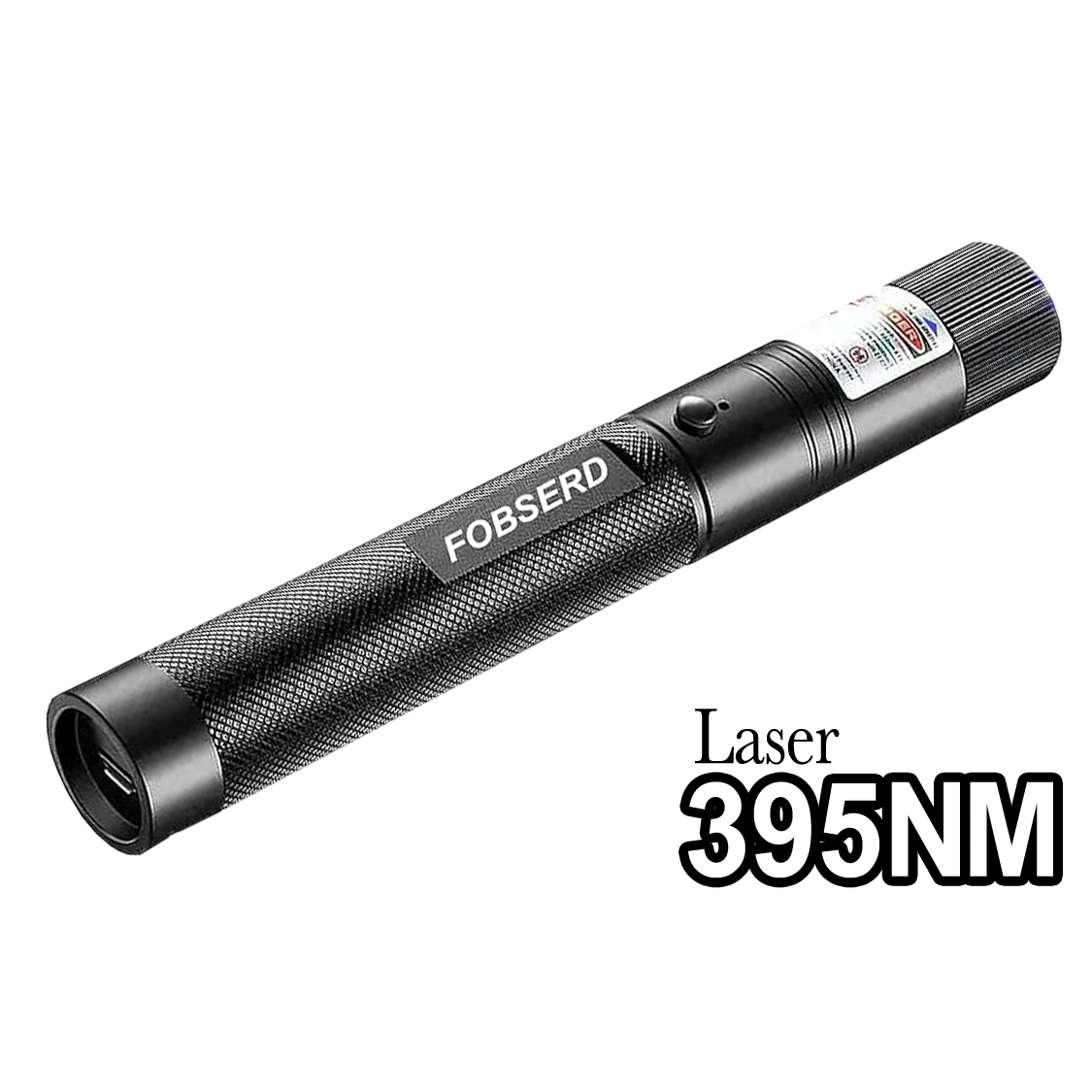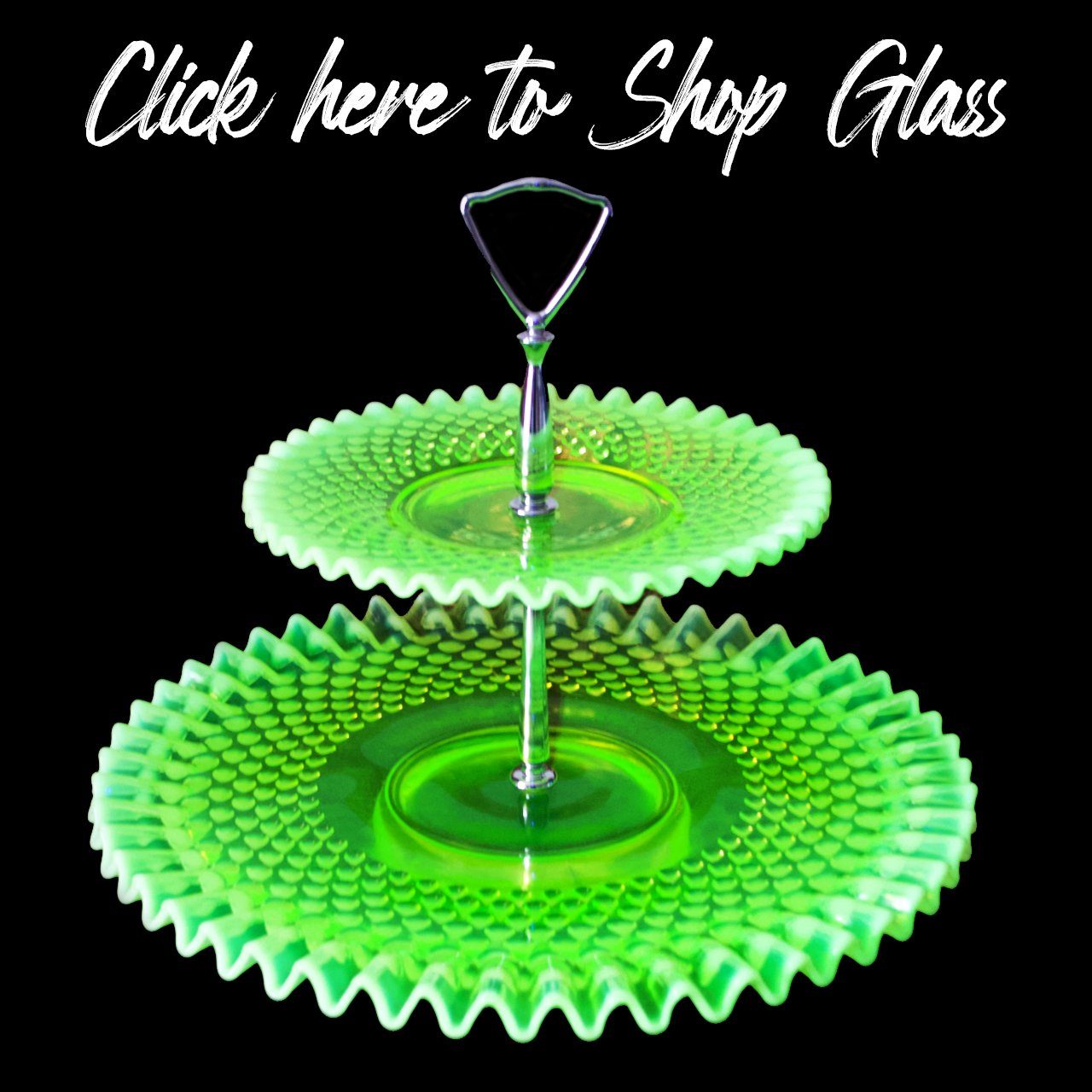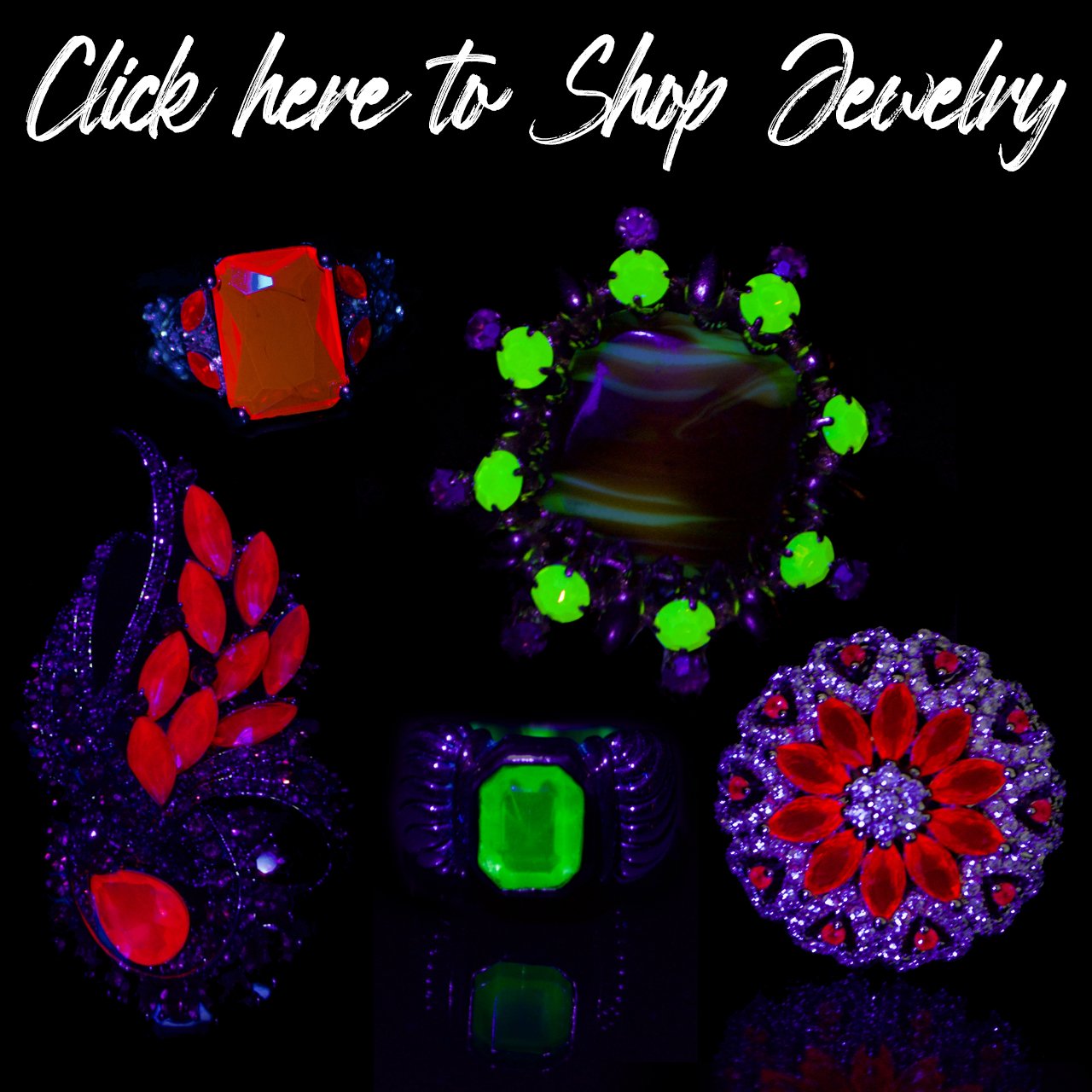About UV Glass
(And Other UV Reactive Antiques)
There are several elements that will cause common glasses to fluoresce under ultra violet light. The fluorescent response depends on several factors: primarily the elements present, sometimes matrix, the concentrations, the wavelength of the exciting radiation, the intensity of the exciting radiation, colorants, etc.
The type of Ultraviolet light and the color of visible light is determined by its wavelength. The unit of measurement for light wavelengths is the nanometer (nm). Ultraviolet light is generally considered to be from 200 nm to 400 nm.
Click Here to learn about 395nm vs. 365nm Lights
Uranium (395nm & 365nm)
Uranium glass is as a blanket term used for any glass containing uranium. It is characterized by the presence of uranium (oxide) and, in some cases, iron oxide.
Unlike the commonly known (green) uranium glass, vaseline glass is a type of uranium glass — referring specifically to the bright lime-yellow (canary) color. Uranium can also be found in some custard glass, Burmese glass, milk glass, jadeite, and opaline glass. It is also (scarcely) seen in blue glass, pink glass or other obscure colors.
Uranium Ghost Glowers: For every rule there is an exception. While nearly all uranium glass will glow brightly under 395nm UV light every once in a while you may come across a piece that really only seems to react under 365nm. Macbeth Evans was one of the most notable glass makers to produce these “ghostly glowers”. But, this is where is gets tricky! Because manganese also fluoresces under a 365nm light, the only way to positively confirm if something is Uranium Milk Glass is to test is with a geiger counter.
Uranium glass can register above background radiation on a sufficiently sensitive Geiger counter, although most pieces of uranium glass are considered to be harmless and only negligibly radioactive. Most uranium glass contains less than a 2% uranium content, however some pieces from the early 1900s can contain up to 25%.
After World War II, using depleted uranium (DU) became more common than using natural uranium ore. DU comes with the benefit of mostly releasing alpha radiation, which can’t penetrate the skin, so it is not considered a serious hazard outside of the body. Collecting Uranium Glass accounts for approximately 1 to 2% of the average American’s annual radiation exposure. In fact, a report published by the US Nuclear Regulatory Commission in 2001 stated that uranium glass is considered to be safer than household electronics.
While it is completely safe to have and display uranium glass in your home, some people recommend not eating or drinking from it as you can accidentally ingest small fragments of radioactive glass.
These specific items should be notably avoided for their original intended use:
Uranium glass citrus juicers, as the acid can etch into the glass and leach out potentially harmful radiation.
Uranium glass knives, as they’re prone to chipping off glass into food while cutting.
Less Common Colors of Uranium Glass:
Clear Uranium Glass by James Whitehurst Glass — He added 11lbs of vaseline glass rods to 50lbs of clear glass to obtain this color. While uranium was never added into clear vintage glass, some modern artists have added it into their clear glass to create incredible works of clear uranium art.
Uranium Glazed Ceramics (365nm / 254nm)
Uranium glass is characterized by the presence of uranium (oxide) and, in some cases, iron oxide. Uranium glazed ceramics can register above background radiation on a sufficiently sensitive Geiger counter. “Radioactive Red” Ceramics are known to be especially “spicy” with high readings on a Geiger counter.
The use of uranium in ceramic glazes ceased during World War II when all uranium was diverted to the Manhattan project and didn't resume until 1959. In 1987, NCRP Report 95 indicated that no manufacturers were using uranium-glaze in dinnerware.
Before the 1970s, many companies used radionuclides to color glazes. The most commonly used radionuclides were uranium, thorium, and potassium. These elements emit alpha, beta and/or gamma radiation – These glazes can be found on floor and wall tiles, pottery, and other ceramics. Uranium was used in the glazes on Cloisonné jewelry to make orange, yellow and green colors. Some Fiestaware produced before 1973 used depleted uranium to create the color of the glaze.
* The U.S. Environmental Protection Agency warns consumers not to use radioactive glazed ceramics for food or drink use, the glaze can leach Uranium and heavy metal into your food (Especially if acidic)
Cadmium & Selenium Glass (395nm & 365nm)
Cadmium Sulphides are associated with making yellow glass and this causes it to glow yellow under UV light. When used in conjunction with Selenium or Sulphur it yields shades of yellow, red and orange glass — resulting in it fluorescing yellow, orange, pink or red under UV light.
*Cadmium is toxic and items containing cadmium should only be used for display, do not eat or drink from cadmium glass.
Selenium Glass (395nm / 365nm)
Selenium was responsible for making glass pink and red and when used together with Cadmium Sulphide an even more brilliant red was created known as Selenium Ruby. Selenium can be found in pink, red and ruby colored glass and fluoresces – some, but not all, glow an intense pink under UV light.
Because selenium does not glow nearly as bright as most Uranium or Cadmium glass you may want to use a large spotlight or single spotlight to get the best glow inside your display.
UV Coated Glass (365nm & 395nm)
True flashed glass is made by dipping a piece of clear glass (sometimes other colors like amber were used) and dipping it into a molted glass mixture to coat in a thin, solid color which imitates fully colored glass with a much lower production cost. However, flash painted glass can also refer to pieces that have a thin coat of paint or stain applied to the surface or sometimes the inside of the piece of glass.
One of the easiest ways to identify a piece of coated glass is to look for scratches and wear on the piece where the paint may have worn down or chipped off. You can also check the bottoms and edges of the glass for evidence of clear glass under the thin coating. This is more noticeable with older or well used pieces.
Some of the modern pieces are a bit harder to identify as the paint may not be scratched or worn yet. Many household chemicals will not easily remove the color on some items. you can preform a scratch test on your piece or simply leave it in perfect shape and enjoy without confirmation.
Painted or stained glass comes in every color of the rainbow and many of them are UV reactive and can easily be confused for lead, selenium, cadmium and even uranium glass! Be sure to inspect your glass thoroughly.
Neodymium Glass (365nm / 395nm)
Neodymium glass (sometimes referred to as Alexandrite glass), changes color according to different lighting conditions. The glass appears lilac (or sometimes pink) in natural sunlight or yellow incandescent light, and smoky blue in fluorescent/white light. This is due to the presence of Neodymium oxide within the glass.
On its own, Neodymium is not UV Reactive. Some manufacturers added Selenium into their glass matrix which resulted in the bright pink fluorescent glow under UV light. Neodymium glass has also been noted to fluoresce a vibrant to dull pink, pale green, or a peachy-orange color depending on the matrix of chemical additives and concentration of those chemical additives — Some pieces require 365nm while others fluoresce beautifully under a 395nm light.
The first commercial use of purified neodymium was in glass coloration, starting with experiments by Leo Moser in November 1927. The resulting "Alexandrite" glass remains a signature color of the Moser glassworks to this day. Neodymium glass was widely emulated in the early 1930s by American glasshouses, most notably Heisey, Fostoria (Wisteria), Cambridge (Heatherbloom), and Steuben (Wisteria), and elsewhere (e.g. Lalique, in France, or Murano). Tiffin's ‘Twilight’ remained in production from about 1950 to 1980. Current sources of production include glassmakers in the Czech Republic, the United States, and China.
Praseodymium Glass (395nm / 365nm)
Leo Moser, son of Ludwig Moser, founder of the Moser Glassworks, investigated the use of praseodymium in glass coloration in the late 1920s, yielding a yellow-green glass given the name “Prasemit”. However, at that time far cheaper colorants could give a similar color, so Prasemit was not popular, few pieces were made, and examples are now extremely rare.
Much like neodymium, praseodymium is a rare metal that has dichroic properties under different lighting conditions. However, instead of turning blue, it turns green under fluorescent light. On its own, Praseodymium is not UV Reactive. Some manufacturers added Selenium into their glass matrix which resulted in the bright pink fluorescent glow under UV light
Europium Glass (39nm / 365NM)
Europium was discovered in 1901 by French chemist Eugène-Anatole Demarçay. It gained practical use only in the mid-20th century, when scientists realized it can produce two different colors, which correspond to two different oxidation states, Eu 3+ (orange-red) and Eu 2+ (blue), without using a reducing atmosphere.— This property makes it a key material in optical and laser glasses, scintillators, and fluorescent lamps.
Europium can sometimes be found in Fenton’s green glass when using a 365nm UV Light
Manganese Glass (365nm)
Manganese is one of the oldest glass additives and was used in small quantities to de-colorize (remove the green tint from glass to make clear) and in higher contents to colorize glass. Manganese can be found in nearly all colors of glass, especially amethyst and turquoise blue glass. Manganese fluoresces green under 365nm UV light, often being confused with Uranium.
High Content Manganese Glass: For every rule there is an exception. While most glass that contains manganese will not fluoresce under a 395nm UV light, some pieces contain a particularly high manganese content which will react under 395nm. Do not be fooled into mistaking this for Uranium Glass, it is not, and can be distinguished by the lack of radioactivity (when tested with a geiger counter) and the subtle differences in color.
Lead, THULIUM, Cerium Glass, and more (365nm/254nm)
UPDATE: August 20, 2024 — New information will be added/updated as evidence comes in.
It has been thought for quite a while that high content lead causes glass to glow bright blue under 365nm UV Light . However, new evidence is showing that this is not the case.
NOTE: There is still no evidence to positively confirm what element is causing the bright blue glow in the modern glasses that we are seeing under UV Light. Any household glass that I have found, confirmed to have cerium is colored, yellow, with the element and the blue glow is very dull compared to what we’re seeing in the clear glasses. Until more research is done we cannot positively confirm the element causing the glow. Please feel free to reach out to me via email with any further research you may have done or found on the subject.
There are several chemicals, or combination of chemicals, that can cause glass to glow bright blue under 365nm: Thulium, Cerium, Silver
Silver doped Barium Phosphate glass — Blueish under UVC 275nm – 312nm
1% Cerium(III) oxide doped Ba-Borate glass – Strong Blue under 365nm
Thulium 3+ doped Zinc phosphate glass — Deep blue under 365nm
Thulium 3+ doped Barium Phosphate glass — Deep blue under 365nm
Cerium: Cerium oxide is used as a decolorizing agent and a colorant used to produce yellow (thorium*) glass. When added to molten glass, cerium oxide can neutralize the yellow or green tint caused by impurities such as iron, chromium, and nickel. Due to its UV Blocking Properties, Cerium is most commonly found in windows, lenses, and mirrors. It is also found in some yellow household glasses
Thulium: because it is very rare and expensive and has little to offer, thulium find little application outside chemical research. Thulium has been used to create lasers. It also has potential use in ceramic magnetic materials called ferrites, which are used in microwave equipment. Thulium-doped calcium sulphate has been used in personal radiation dosimeters because it can register, by its fluorescence, especially low levels.
Silver: Since several decades, silver has gained a peculiar place among the dopants for obtaining glassy materials with specific prescribed properties. Among these, Ag coloring of the glass is perhaps the oldest one to be exploited. As a matter of fact, empirical recipes to obtain silver nanostructured glasses have been used since literally millennia in the production of glass artworks exhibiting peculiar optical properties. The most famous examples are probably the artistic manufacts of Roman empire glassmakers, as well as the stained glass windows of medieval cathedrals that may be found throughout the whole western Europe.
It is now being speculated if lead is reacting under 365nm at all. Lead content does however, fluoresce with a short-wave 254nm light.
(Don't mistake the reflection of visible purple light from the UV light for Blue chemical fluorescence)
*Though occasionally drinking out of lead glasses may not be the end of the world, the FDA warns that having lead-contaminated glasses within children’s reach at home can result in dangerous exposures. This glassware also poses greater danger to pregnant women, the FDA says.
Daylight ~5000k, over
~365 nm bandpass filtered, and
~254 nm bandpass filtered
XRF Readings courtesy of Scott Philbrick at Anything Glows!
*Note that Cerium is not present in the readings.
Thorium / Cerium Glass
Some transparent yellow or yellow-green glass has been colored using cerium oxide, that it can easily be confused with Vaseline glass in natural light. This cerium colorant is sometimes obtained from thorium-rich monazite sands. Incomplete chemical separation has resulted in accidental addition of significant quantities of thorium to the glasses. To confuse matters somewhat, cerium glass is sometimes radioactive due to the presence of thorium impurities (and rarely, uranium impurities*) that can also be identified with a Geiger counter.
Thorium glass can be identified by gamma-ray spectroscopy, but it is simpler and cheaper to distinguish between thorium glass and other radioactive glasses by use of a Geiger counter. A 0.5-cm thickness of aluminum shielding between the glass and detector reduces gamma-ray counts from uranium-containing or 40K-containing glasses to less than 1% of the unshielded radiation. In contrast, identical shielding allows 10% of the unshielded thorium radiation to reach the counter. Visible absorption spectra and fluorescence properties of yellow thorium glasses are also different from those of uranium glasses
Samples of yellow glass dinnerware produced by twelve different U.S. companies during the 1930's-1950's have been found to contain thorium.
When purposefully added to glass, thorium dioxide helps increase its refractive index and decrease dispersion. Such glass finds application in high-quality lenses for cameras and scientific instruments. The radiation from these lenses can darken them and turn them yellow over a period of years and has the potential to degrade the film if the latter was left in the camera for a substantial period of time.
Thorium, on its own, is not UV Reactive. However, other additives or accidental impurities within the glass may be.
Phosphorescent Glass
Phosphorescent Glass is a glow-in-the-dark substance which is energized by light, producing it to glow for a period of one to several hours. Phosphors are often added into the glass in the form of a powder or in small chunks, as photographed above.
Sunlight, UV light, or the light on your side table are all sufficient to produce a glow from these types of glass. It is generally safe (non-toxic & not radioactive) depending of the other additives within the glass matrix.
Boron Nitride (395nm & 365nm)
Boron Nitride is a mold release agent that sometimes reacts with chemicals in (Ruby / Red) glass which makes them UV Reactive. This is sometimes confused with cadmium glass because it fluoresces a similar yellow-green color.
Cadmium Glass vs. Boron Nitride: Be sure not to confuse the fluorescence of cadmium glass with that of boron nitride. The easiest way to tell is by the color difference. Boron Nitride will fluoresce yellow-green under UV light, while Cadmium fluoresces yellow-orange.
It should also be noted that some pieces can contain both cadmium and boron nitride.
Radium Paint (395nm & 365nm)
The first material applied to watch dials for nighttime luminescence was radium paint, which, thanks to radium’s half-life of 1,600 years, offered a long-lasting glow during that period before dimming — the catch being that, as its name implies, radium (specifically Radium-226) is radioactive. In the 1920s, the mostly female factory workers that painted the watch dials with radium compounds started falling ill and dying at alarming rates, leading to lawsuits against the companies that produced the material and eventually, safer working conditions and an abandonment of radium as a luminous substance in watchmaking by the 1960s.
Promethium Paint (395nm & 365nm)
Replacing radium for a short time as the luminous substance on watch dials was a compound called Promethium (Pm-147), which was less radioactive but had a half-life of only two-and-a-half years and thus a much shorter period of luminescence. Next up was Tritium H-3
Tritium Paint (395nm & 365nm)
Tritium H-3 is a radioactive isotope of hydrogen with a respectable half-life of 12.3 years and, as a low-energy beta emitter, far less hazardous to work with than radium. Tritium was not entirely without risk, however. Used on surfaces like dials, tritium had a tendency to diffuse, seeping through the case and into the skin of a wearer. Tritium-based paints on dials, which were used by numerous watch brands, including Rolex, were banned in 1998.
Doll Eyes
Some doll eyes have been known to change color over time, usually due to heat or exposure to sunlight, which has turned some of them vibrant shades of green or pink. It is not exactly known why they glow green under UV light, however is it assumed that it has something to do with either the adhesive, resins, or pigments used. None of my dolls have tested positive on my geiger counter for uranium and it is disputed if any at all ever contained uranium.
If you have further information or if you have a doll that does test positive, I would love if you sent me an email.
Plastic
Plastics like resin, acrylic, lucite, etc are sometimes UV reactive. These items are often confused for UV Reactive glasses like Uranium, Cadmium, Selenium or Lead. You can usually tell the difference between plastic and glass my feeling it (Glass is usually cold to the touch while plastic is warm) or tapping (Glass emits a distinct ringing sound or a soft tink, while plastic typically yields a dull click, even with gentle taps). There are several other ways to test for plastics, so you can be sure to properly identify if your item is glass or not.
What Glows Purple?
Is it glowing purple or is it just the purple UV light reflecting off the surface? be sure not to confuse the refection of your UV light, off of a bright surface, as a glow. The intensity of the UV light source can influence how the object appears. A stronger UV light source can cause some objects to reflect more light overall making is look as if it may be glowing when it is not.
Other Glowing Elements Found in Glass
Other uncommon UV Reactive elements that can be found in glass: Terbium, Samarium, Dysprosium, Yttrium, Cobalt Oxide, Copper oxide and more…
The Lights I Use:
— Please feel free to email me to help improve this blog —
Anything that needs correction, suggested additions, information you think should be added, etc. I would love to hear your feedback.
Shop more of my glass, in person, at Fae’s Cabinet located on 3210 Crescent Ave Fort Wayne, IN 46805










